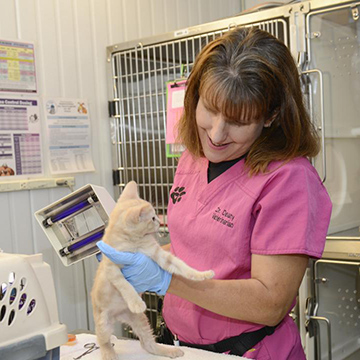Note: The deadline to apply for this position has passed. We’ll be expanding our team in the coming months, so keep an eye out for other opportunities to join the KSMP!
In a historic move, the governor of California tapped the Koret Shelter Medicine Program to lead a five-year, 50 million dollar initiative not only to recover from the pandemic but also to realize California’s goal of becoming a truly humane state that does not euthanize healthy or treatable animals. Originally proposed in 2019 and put on pause by the pandemic, the California legislature voted to make it official with the 2021 state budget.
That’s where you come in!
We’re hiring a California State Director to lead the kind of large-scale change initiatives that have a huge impact and squeeze every ounce of opportunity out of this statewide pilot. More animals pass through shelters in California than in any other state in the nation; we’re hoping the innovations that allow us to get it right here will serve as an example for the rest of the United States.
A little about the Koret Shelter Medicine Program
The KSMP was established in 2001 as the first university-based shelter medicine program in the world. For the last twenty years, we have developed and spread a welfare-oriented, community-centered approach to animal sheltering and services.
Here’s some of what we’ve accomplished so far:
- Our research has led to advancements in vaccine schedules and protocols that have protected millions of animals from life-threatening diseases.
- Our management model, Capacity for Care (C4C), has been peer-reviewed, published and proven to dramatically improve both the welfare and live outcomes of animals. C4C has enabled thousands of shelters to serve their community more efficiently and allowed staff to take pride and feel joy at work.
- Together with the University of Florida, we co-founded the world’s largest feline life-saving initiative, the Million Cat Challenge, and surpassed our goal of saving one million more cats a year early. Today, shelters enrolled in the Challenge have spared 3.5M cats and kittens from euthanasia.
- Many of those 3.5 million cats will have passed through a portal, a KSMP invention that retrofits feline housing and reduces stress and upper respiratory infections in hundreds of thousands of cats worldwide by providing the space they need to exhibit natural behaviors.
- Over six thousand animals have been sterilized by UC Davis fourth-year veterinary students completing a high volume spay and neuter rotation at our local animal shelter hosted by KSMP.
There is an impression that our team is larger than it really is; in fact, the program you will be leading is small and scrappy. Our commitment comes from our shared belief that inside animal shelters are hard-working and innovative professionals that know what their community needs to move forward; our job is to give them the tools and help them shape the path to the humane outcomes they desire. In exchange, we discover and help magnify the successes being achieved by shelters across the nation. This virtuous cycle has enabled us to scale our efforts year after year and build the infrastructure that has prepared us to grow our program substantially and support California through our next transformative chapter.
A brand-new position created for this once-in-a-lifetime opportunity. Is it yours?
We’re looking for someone that loves building and scaling new programs. Someone intimately familiar with animal welfare and the sheltering culture is important for this role (extra bonus for the professional that already has an extensive network in California) but equally important is your experience managing teams, building engagement, will, and enthusiasm. We serve communities through animal shelters; communities are not made up of pets alone. The human-animal bond is central to everything we do. If you’re ready to invest your time and talent into something that makes a positive impact, something that magnifies the good, something measurable, something that will inarguably improve the lives of pets and the people that love them, look no further.
What would I be doing, specifically?
This position will provide strategic guidance to the team on unique challenges facing the sheltering community. A typical week leading this project would include building a statewide community among animal shelters; working closely with our deputy director to ensure different elements of this project are on track and planning our next grant opportunity; reviewing the progress of shelters we are working with and consulting with our other internal teams to see the full picture; and meeting with external partners to leverage every possible strategic investment in our goal.
As a manager of 2-3 staff, providing feedback and developmental opportunities as needed to recognize and/or improve performance and capacity will also be an important part of this role. You’ll also be part of our team expansion, so you would be leading the process of recruiting, interviewing, and onboarding additional members of the California for All Animals initiative. Of course there would likely also be typical university administration tasks, human resource duties, budget management tasks, and some oversight of the grants processes.
A few of the EI/EQ qualities we think our new leader needs to succeed.
We are looking for someone flexible but steady. Every personality type under the sun shines through the members of our team and those we serve. We are constantly changing and innovating, and you have to enjoy (or at least be okay with) that sort of thing to thrive on this team.
You must be passionate about the KSMP mission and helping communities of all shapes and sizes. The phrases “large-scale change,” “cohort building” and “community engagement” should turn your head in a conversation. If you’re not a disciplined self-starter, it would be nearly impossible to succeed in this role.
As mentioned, we have big goals and a small, growing into a medium-sized team. To achieve our aims, we operate with excellence in mind in all matters, with the confidence to discuss and present ideas without ego interfering. We don’t always get it right, but we are committed on a cellular level to continuous improvement. You’ll need to have the kind of grit that wires you that way, too.
That doesn’t mean we’re a humorless bunch. Fun is important to us. We don’t goof off all day, but we fully encourage a light spirit that promotes healthy team culture, creativity, and imagination. In fact, it is an important part of our brand identity.
We are part of a vibrant and expanding community
The Koret Shelter Medicine Program (KSMP) is an education and research unit within the School of Veterinary Medicine at the University of California, Davis. The program supports the health and welfare of animals by applying the principles of shelter medicine to community animal management through shelters. Shelter Medicine defines a broad specialty that includes medicine, management, behavior, and the epidemiological study of community dynamics related to companion animal management.
Is this position speaking to you? Do you live in California or would you be open to the possibility? We’d love to hear from you!
The deadline to apply for this position was October 20.
Note: Davis is a great town, but you don’t have to move here as long as you reside in California. Please feel free to email sheltermedicine@ucdavis.edu if you have any questions.



